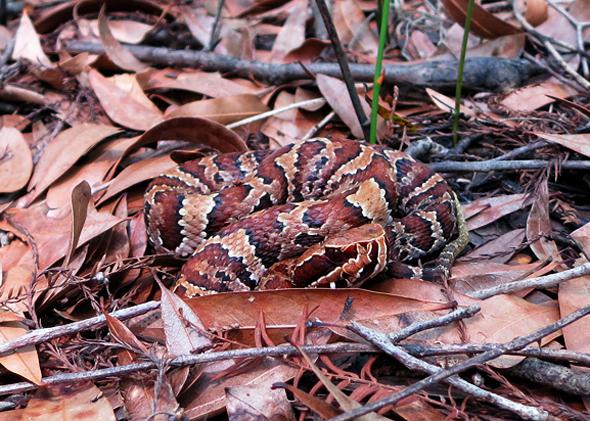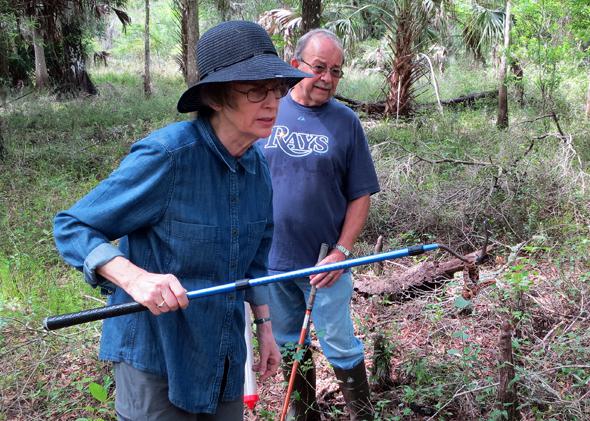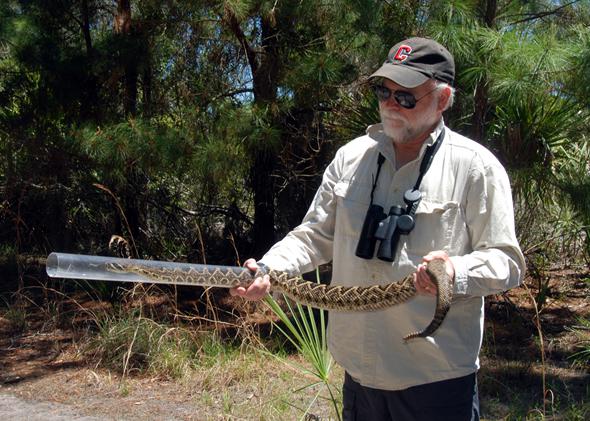“You will be surprised how relaxing it is to be around cottonmouths,” said herpetologist Harry W. Greene as we put on our boots for a morning walk through a Florida cypress swamp.
It would indeed be surprising for me to feel relaxed near venomous snakes. Like many, maybe even most, people I have a deep-seated fear of snakes. It’s very likely the startling way they move that causes me and others to experience the “Tighter breathing/ And zero at the bone” described by Emily Dickinson.
But snake-fearers (ophidiophobia is the psychiatric term) miss something—knowledge of a strangely beautiful animal with complex behaviors. Many snake-fearers torture themselves by seeking out exaggerated tales of snake attacks, and the cottonmouth figures in the most outlandish of these stories. Greene, one of the world’s most respected ophidiophiliacs, says snakes are feared out of proportion to the risk they pose, and we are thus blind to their qualities.
Snakes move like water flowing out of a pitcher. The semi-aquatic cottonmouth takes that disconcerting motion to another level—it moves through water like water moving. As its Latin name (Agkistrodon piscivourous) implies, cottonmouths eat fish, and they can bite underwater. The cottonmouth sets itself apart from other water snakes with a distinctive swimming style, its body riding high in the water with its head held up, like a proud pharaoh.
The Florida morning ended with a beautifully patterned young cottonmouth, a bit longer than a foot, probably less than a year old. When we first approached, it coiled and gave a half-hearted gape, a moderate version of the display of its shockingly white mouth, the source of its common name. (Another common name is water moccasin.) Young cottonmouths have brown and tan bands, touched with paler colors; adults darken to deep olive-gray or black for camouflage in murky water.
My snake, as I came to think of it, was captured and held, gently, at the end of a snake stick, which is 3-feet long and curved at the end like a shepherd’s crook. Greene handed me the stick, with snake. I could be minimally relaxed because I was in the company of an experienced herpetologist (who had been bitten by a venomous snake only once in his life), and the boots I was wearing were very thick. After the little snake was released, it stayed around, trusting that it was camouflaged in leaf litter, and Greene crouched no more than a foot away to take photos.
The cottonmouth’s combination of white mouth and exposed sharp fangs is a clear signal: “I’m armed; if you don’t back off, there are consequences.” Greene compares the snake to Clint Eastwood in Dirty Harry. Though that violent human being is far more likely to follow through on his warning.
This snake was soon returned to the swamp to face the many enemies of young cottonmouths—great blue herons, king snakes, largemouth bass. Full-grown cottonmouths, heavy-bodied and up to 5-feet long, have few predators except for human beings.

Courtesy of Harry W. Greene
To be bitten by a cottonmouth is extremely painful and can cause permanent tissue damage. (Even the young pack a full dose of venom.) Cottonmouth venom is hemotoxic, destroying red blood cells and interfering with clotting. If you had to choose, a cottonmouth bite would be better than that of a coral snake, whose neurotoxic venom attacks the central nervous system. Being cautious, herpetologists stress, means walking away and leaving a snake alone, not shooting it.
Cottonmouths live in marshes, swamps, and creeks in the Southeastern states, regions where many people fish and hunt. Some sportsmen have a tendency to exaggerate, whether it’s the size of the fish or the aggressiveness of the snake, and the cottonmouth makes a dramatic villain.
The biggest, scariest cottonmouth-related myth—the writhing mass—has persisted perhaps since the dawn of water skiing. The setting: a lake in a southern state. The action: a guy is water skiing. (Sometimes it’s a girl in a bikini, sometimes it’s a lovable young mother of four children out boating with her family, talked into trying water skiing for the first time.) The boat takes too slow a turn and the skier sinks in shallow water. He’s fearful because he’d heard there was some rusty barbed wire underwater. He realizes, horribly, that it’s not barbed wire; it’s a nest of cottonmouths. When pulled into the boat, he’s half-dead, bitten 40, maybe 50, times. In some versions the cottonmouths are still holding on all over his body.
Sometimes the snake pack story is simplified: A boy yells, “Last one in is a rotten egg!” and then dives into a ball of cottonmouths. As he perishes, he cries out to his friends not to follow him.
The origin of the tales is mysterious; we will leave that to psychoanalysts, but it keeps getting repeated. The unlucky water-skier is mentioned in Willie Morris’ 1967 memoir of growing up in Mississippi, North Toward Home. In the 1989 miniseries Lonesome Dove, from Larry McMurtry’s 1985 novel, a young cowboy fording a creek falls from his horse into a nest of cottonmouths. Lonesome Dove happens to be Harry Greene’s favorite movie, and he gives McMurtry and the filmmakers a pass for poetic license. To depict the real process of the cowboy’s death from even a single cottonmouth bite, Greene says, the filmmakers would have to indicate that it took weeks.
The basic fact that gives rise to the legends is that cottonmouths are the only venomous aquatic snakes in the United States (semi-aquatic to be precise). The idea of encountering a snake while swimming is utterly terrifying. Though the snake’s reaction, a nice parallel to the human being’s, would be to swim away as fast as it could.
Those terrible encounters with multiple cottonmouths never happened and never could happen in nature. Cottonmouths are solitary; they do not form nests or colonies. Males fight other males in the spring for access to females. Males and females pair for a few hours of courtship and mating, then they part. Females bear 10 to 15 live young that move out on their own as soon as they are born. Occasionally, in a drought, a few cottonmouths might join other water snakes to consume fish stranded in shrinking pools.
Rattlesnakes cause the largest number of snakebite fatalities in the United States, on average less than 10 per year. In the 20 years leading up to 2003 (the last date for good records) there were zero fatalities from cottonmouth bites. Part of the reason is that cottonmouths often deliver what herpetologists term a “dry bite,” striking without injecting venom. When the fangs puncture the prey, the muscles around the poison sacs squeeze the venom along ducts leading to the fangs, acting like the plunger of a hypodermic. Somehow the snake that prefers to inflict a dry bite can control the movement of the venom. A dry bite is an advantageous behavior: Venom is to subdue prey; it’s wasted on something too big to eat. It’s also expensive for the snake to produce—it takes three weeks to refill the supply.
Reasonable people will agree that cottonmouths don’t entrap you, pursue you, and are unlikely to kill you. But reasonable people, even some herpetologists, persist in saying they are aggressive. There’s an element of narcissism in the perception of aggression; it’s presumed that a snake must find human beings very interesting. It’s hard for us to accept that they really don’t care. What they care about is eating and breeding.
The accusation of aggressiveness is hard to shake, though Whitfield Gibbons, University of Georgia author of Snakes of the Southeast, published a 2001 scientific paper illustrating that a sample of more than 40 cottonmouths gathered in the wild reacted with surprisingly little aggression even when sorely provoked.
He and his co-author, Michael E. Dorcas, found the research difficult, but not because of risk—the snakes took off as soon they saw Gibbons and Dorcas coming. The ones that could be restrained were subjected to an escalating series of treatments, the more irritating of which, if performed on a person in a New York City subway car, would get them arrested. The two professors began by simply standing beside the snake. Some test snakes opened their mouths, but none bit. Then the two men moved on to nudging each experimental snake for 20 seconds. More than one-half of the snakes used threat displays, but none bit. Then the experimenters placed a booted foot in the middle of each snake’s spine. Most of the snakes took defensive postures, and one bit, though Gibbons calls it just a nip. Finally the two picked the snakes up using a prosthetic hand complete with a flannel shirtsleeve and watch, presumably outdoorsman’s garb. The fake arm prodded the snakes roughly. Only 13 of 36 cottonmouths subjected to the prodding reacted by biting, many with dry bites.

Courtesy of Harry W. Greene
“Our findings challenge conventional wisdom about aggressive behavior in an animal perceived as more dangerous than it is” the paper concluded. Gibbons said his motivation was “to have people get more appreciation, or at least less dislike, for these animals. And it was fun to do, definitely.”
A less formal series of experiments on YouTube disprove cottonmouth’s aggressive nature. Orry Martin, Texas snake hunter, tests whether he can make the cottonmouth pursue him by running away screaming. The snake does not move. Then he says it may have to be a woman’s scream, so he recruits his mother for an off-camera vocal. No reaction. The sedentary snake finally, reluctantly, bites when Martin puts the tip of his cowboy boot in its mouth.
There’s an accurate and respectful observation of cottonmouths by William Faulkner in his 1939 short novel Old Man, collected under the title Wild Palms. The hero is a convict temporarily released to rescue people stranded by the 1927 Mississippi River flood. He and the pregnant woman he rescues land on an island. “He had almost reached the flat crest with his now violently unmanageable burden when a stick under his foot gathered itself with thick, convulsive speed.” Like Gibbons’ snakes, the island snake does not bite. Shortly after, on the same island, Faulkner writes, “This time he thought it’s another moccasin as the thick body truncated in that awkward reflex, which had nothing of alarm in it but only alertness.”
Greene, Gibbons, and other herpetologists give the cottonmouth credit for alertness, curiosity and even, possibly, intelligence. “Once they rank snakes,” Greene says, “cottonmouths may well turn out to be the smartest.”
Herpetologists study amphibians (frogs, toads, salamanders) as well as reptiles (lizards, snakes, crocodiles). A common way of capturing amphibians is to put up a plastic fence that channels them toward buckets sunk in the ground. A short article in Herpetological Review records that an enterprising cottonmouth was observed going from bucket to bucket, hanging by its tail and plucking out frogs to eat.
A cottonmouth’s life is very quiet and patient. The snakes spend only about 5 percent of their time moving. Much of the daytime is spent basking in the sun to maintain their body temperature. They hunt mainly at night using spectacularly adapted prey-sensing organs. Cottonmouths, like North America’s copperheads and rattlesnakes, are pit vipers. The heat-sensitive pit, on either side of the head between the nostril and the eye, can detect temperature differences as small as 1.8 degrees higher or lower than background. That means pit vipers can strike accurately at a source of heat. The system works better at night, when a mouse or bird is much warmer than the surrounding air. Cottonmouths’ eyesight isn’t great, but the pit is another way of, essentially, seeing. The forked tongue picks up scents and indicates in which direction the source of the scents lies. Mammalian prey is struck and released, then tracked by scent as the animal becomes debilitated by the injected venom. Frogs and fish are held and consumed; a cottonmouth usually pulls captured fish on land for swallowing.
Scent is also used to find mates. A male cottonmouth, like many snakes and lizards, has what’s called a hemipenis, a misnomer. He doesn’t have a half-penis, he has two penises, each one draining a single testis. These alternate. As with so many animals, cottonmouth mating begins with the male nudging the female’s back and sides. It can take hours for her to become receptive and open her cloaca. The two-pronged hemipenis helps them stay coupled as they writhe.
Maybe not in the act of mating, but cottonmouths and human beings are likely to see more of each other. The natural areas populated by snakes are being gobbled up by development, forcing snakes to make do with fragments of habitat, and sometimes that’s someone’s backyard.
Greene advises us to show caution but also some respect. Venomous snake have been on the Earth for at least 35 million years; try looking at things from their point of view. A fairly common tale told in the South by golfers back in the clubhouse is that they encountered a huge cottonmouth (in these stories it’s always huge) and they had to beat it to death. From the snake’s point of view, there were giants. In fact, giants with clubs. In any case, the fairway snake was highly likely to have been a non-venomous water snake; many thousands of them are killed every year, mistaken for cottonmouths.
There is a peaceable kingdom for cottonmouths and human beings. It’s a place that would be an ophidiophobia-sufferer’s nightmare, but where Greene and many others have walked safely among snakes that were preoccupied and satisfied. Seahorse Key is an island off Florida’s Gulf Coast that’s one of Florida’s largest nesting grounds for hundreds of bird species, including pelicans, ibis, and egrets. Masses of snakes lie near and sometimes underneath the sea birds’ nests. The snakes are gathered there to feed on hunks of fish regurgitated by the parent birds or dropped by the chicks. (The snakes, normally nearly black, are coated with white bird droppings.) Greene said he had never seen cottonmouths relaxing in a crowd like that. The attraction for the snakes was obvious—food falling from the sky. The snakes were gregarious and plump compared to a swamp or creek cottonmouth actively foraging. The birds probably benefit because the snakes scare off the island’s egg-eating rats. Greene recalls it was one of the few fieldtrips on which he was injured. He was hit in the head by a half a mullet.
